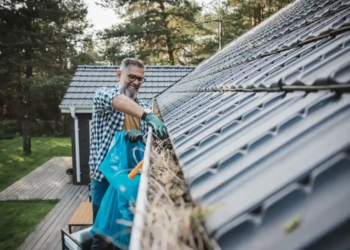By: RENTCafe
It’s hard to anticipate what might happen as your child learns to crawl and eventually walk. Some children climb everything in sight, while others only touch things at their level.
Either way, it’s essential to childproof your owned or rental
Get Started Early
Making your home safe for a baby is a big task, so get started early. It takes longer than you might think to make sure you have all of the safety basics covered and emergency plans in place.
Because some preparations will take time, it’s easiest to babyproof your home before your little one arrives. Once you bring the baby home, your newborn will keep you busy and your hands full, and your ability to complete do-it-yourself projects will be limited.
Enjoying our content? Subscribe to our free weekly newsletter to get Canadian real estate market insights, news, and reports straight to your inbox.
Make a Game Plan
There are several ways to tackle a big project like babyproofing. One strategy is to perform all of the necessary tasks and upgrades one room at a time. For example, you could secure the kitchen from top to bottom before moving on to the living room. Alternatively, you could choose to work on a specific category—such as cabinets—and install cabinet locks throughout the house before moving on to the next item.
With either approach, it’s more important to address life-threatening precautions first and then work your way toward those that might only cause bumps and bruises. Studies show that choking and suffocation are the biggest hazards for children less than one-year-old.
Prepare for Emergencies
If something bad happens, you’ll need to be able to communicate immediately with loved ones and first-responders. To make this easier in the event of an emergency, have these done ahead of time:
- Enter emergency contacts and medical information into your cell phone.
- Keep a landline phone in the house until all occupants are old enough to carry mobile phones. Print a list of emergency numbers and post them near the landline.
- Make sure apartment numbers are visible. If you rent an apartment in Chicago or other big American or Canadian city, for example, with look-alike units, ask your landlord to add directional signs so first responders can locate your unit quickly.
- Install carbon monoxide and smoke detectors on every story of your home. If you already have them, test them to ensure they’re functioning properly. Purchase a fire extinguisher for the kitchen.
Ensure the Whole House is Safe for Occupants
Babyproofing includes checking for things that pose a direct risk to children and the rest of the family. So, start by ensuring that your home is safe for all occupants.
- If you rent or own a residence built prior to 1978, there’s a good chance that
lead paint was used at some point. Dust from lead paint can be harmful if ingested.Although it’s considered safe if it’s completely covered and sealed by new layers of paint, areas like doors,banisters , and window sills may chip, flake, and peel easily—potentially exposing children to this danger. - Living in an older building also carries the risk of asbestos exposure. If asbestos-based building materials are disturbed by a renovation or simply deteriorate over time, floating asbestos
fibers could pose a health threat. - If you’re renting with kids and your apartment has a community pool, make sure there are proper barriers with child-resistant gates. Ask the community manager if
theswimming pool drain cover is compliant with regulations that minimize suction entrapment. - Set your water heater temperature to a maximum of 120 degrees Fahrenheit to avoid scalding.
- Cover radiators and fireplaces with screens to prevent burns.
- Make sure paint and other flammable substances are stored in airtight containers on high shelves in a cool, dry area.
Eliminate Strangling and Choking Hazards
Avoiding items that are small enough to choke on is a constant challenge. Even food dropped from the table can be hazardous if it’s the wrong size and shape.
- Vacuum regularly to suck up small items that could cause choking, including food.
- Tie back cords on blinds or curtains—or install cordless blinds—to minimize the risk of strangling.
- Remove the plastic caps on doorstops, which are choking hazards.
- Relocate small items—like refrigerator magnets, batteries, paper clips, and other small items—out of reach of tiny hands.
- Move any plastic dry-cleaner or grocery bags out of reach
Address all Poisoning Risks
Even with safety latches, bottom cabinets and drawers should only be used to store items that are safe for baby to find. Pots, pans, and food storage containers, for example, might leave a bruise, but they’re unlikely to harm children. Additionally:
- Eliminate any toxic houseplants.
- Transfer cleaning supplies and detergents to high or locked cabinets.
- Clear medicines, vitamins, cosmetics, and shampoos off of counters; they pose a poison risk, so move them to a high or locked cabinet. Child-resistant caps aren’t childproof, either; a persistent toddler may be able to get them open.
- Place liquor in high or locked cabinets.
Minimize the Risk of Toppling Furniture and Items
Climbing on furniture is dangerous because it could overturn and fall on a child. Babies can also use furniture to access open windows or pull appliances down on top of them. To prevent this from happening:
- Move chairs, trunks, and tables away from your windows so baby can’t climb up them and fall out the window.
- Secure TVs, bookshelves, and dressers to walls so they won’t topple over.
- Unplug small appliances—like toasters, blenders, or food processers—between uses to minimize electrocution.
- Use heavy-weight picture hooks to prevent pictures from falling off the walls.
- Tape or tie down loose or dangling cords so that pulling on them won’t dislodge or topple the appliance.
Drawers, Doors, Lids, and Corners
Ensure that whatever baby might try to open, pull on, or play with won’t hurt them. Usesafety gates at the top and bottom of stairwells, entrances to rooms, or any space that’s off-limits to a baby. Plus:
- Install non-slip pads under area rugs to minimize tripping.
- Cover sharp furniture edges and corners with safety padding.
- Block electrical outlets with safety plugs or plastic covers.
- Latch drawers, doors, or cupboards that are within baby’s reach, and move sharp objects to high, locked drawers.
Not Always Having to Say No
Making a house safe takes more than locking the cabinets and padding corners. Having a safe space for kids means you won’t always have to say no. Moving things that are fragile or breakable saves the object, prevents your child from being cut or bruised, and heads off a fight of wills. Even if your child is obedient and follows the rules, you still need to babyproof; it only takes a moment for little ones to get into something they shouldn’t touch!
This guest post was brought to you by RENTCafe.com, a national apartment search website that enables you to find apartments and houses for rent directly from property managers.














